
The priest quickly sliced into the captive’s torso and removed his still-beating heart.
That sacrifice, one among thousands performed in the sacred city of Tenochtitlan, would feed the gods and ensure the continued existence of the world.
Death, however, was just the start of the victim’s role in the sacrificial ritual, key to the spiritual world of the Mexica people in the 14th to the 16th centuries.
Priests carried the body to another ritual space, where they laid it face-up. Armed with years of practice, detailed anatomical knowledge, and obsidian blades sharper than today’s surgical steel, they made an incision in the thin space between two vertebrae in the neck, expertly decapitating the body.
Using their sharp blades, the priests deftly cut away the skin and muscles of the face, reducing it to a skull. Then, they carved large holes in both sides of the skull and slipped it onto a thick wooden post that held other skulls prepared in precisely the same way.
The skulls were bound for Tenochtitlan’s tzompantli, an enormous rack of skulls built in front of the Templo Mayor — a pyramid with two temples on top. One was dedicated to the war god, Huitzilopochtli, and the other to the rain god, Tlaloc.
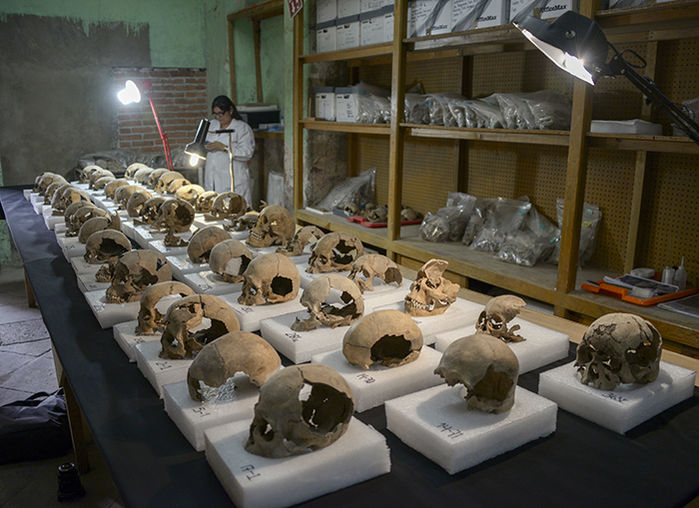
Eventually, after months or years in the sun and rain, a skull would begin to fall to pieces, losing teeth and perhaps even its jaw.
The priests would remove it to be fashioned into a mask and placed in an offering, or use mortar to add it to two towers of skulls that flanked the tzompantli.
For the Aztecs — the larger cultural group to which the Mexica belonged — those skulls were the seeds that would ensure the continued existence of humanity.
They were a sign of life and regeneration, like the first flowers of spring.
But the Spanish conquistadors who marched into Tenochtitlan in 1519 saw them differently. For them, the skulls — and the entire practice of human sacrifice — evinced the Mexica’s barbarism and justified laying waste to the city in 1521.
The Spanish tore down the Templo Mayor and the tzompantli in front of it, paved over the ruins, and built what would become Mexico City. And the great rack and towers of skulls passed into the realm of historical mystery.
Some conquistadors wrote about the tzompantli and its towers, estimating that the rack alone contained 130,000 skulls. But historians and archaeologists knew the conquistadors were prone to exaggerating the horrors of human sacrifice to demonize the Mexica culture. As the centuries passed, scholars began to wonder whether the tzompantli had ever existed.
Archaeologists at the National Institute of Anthropology and History (INAH) here can now say with certainty that it did. Beginning in 2015, they discovered and excavated the remains of the skull rack and one of the towers underneath a colonial period house on the street that runs behind Mexico City’s cathedral. The other tower, they suspect, lies under the cathedral’s back courtyard.
The scale of the rack and tower suggests they held thousands of skulls, testimony to an industry of human sacrifice unlike any other in the world. Now, archaeologists are beginning to study the skulls in detail, hoping to learn more about Mexica rituals and the postmortem treatment of the bodies of the sacrificed.
The researchers also wonder who the victims were, where they lived, and what their lives were like before they ended up marked for a brutal death at the Templo Mayor.
“This is a world of information,” says archaeologist Raùl Barrera Rodríguez, director of INAH’s Urban Archaeology Program and leader of the team that found the tzompantli. “It’s an amazing thing, and just the kind of discovery many of us had hoped for,” agrees John Verano, a bioarchaeologist at Tulane University in New Orleans, Louisiana, who studies human sacrifice.
He and other researchers hope the skulls will clarify the role of large-scale human sacrifice in Mexica religion and culture — and whether, as scholars suspect, it played a key part in building their empire.
The discovery of the tzompantli began the same way all the Urban Archaeology Program’s digs do: with a planned construction project in the heart of downtown Mexico City.
Whenever someone wants to build in a seven-block area around the Templo Mayor, Barrera Rodríguez’s team must excavate first, salvaging whatever remains of the colonial and especially Mexica city beneath.
The finds are often significant and surprisingly intact. The Templo Mayor itself came to light in the 1970s, when INAH archaeologists were called in after city electrical workers stumbled on an imposing circular statue of the goddess Coyolxauhqui, who was killed and dismembered by her brother Huitzilopochtli.
Much of the temple had survived to be discovered. The Mexica built it in seven phases between 1325 and 1521, each corresponding to the reign of a king. Each phase was built over and around the earlier ones, embedding the Templo Mayor’s history within it like a set of Russian nesting dolls.
Although the Spanish destroyed the temple’s final phase, the smaller temples from earlier reigns were paved over but left relatively unscathed. Those ruins are now part of the Templo Mayor Museum. But many structures that surrounded the ruins remained hidden beneath the dense colonial city—and now, the modern megalopolis.
So when Barrera Rodríguez got the call to excavate a site just a few buildings down from where Guatemala Street dead-ends into the Templo Mayor complex, he knew the dig could lead to a major discovery.
Starting in February 2015, his team dug about 20 test pits, unearthing modern debris, colonial porcelain, and, finally, the basalt slabs of a Mexica period floor. Then, he remembers, “Hundreds of skull fragments began to appear.” In more than 2 decades of excavating in downtown Mexico City, he had never seen anything like it.
Barrera Rodríguez and INAH archaeologist and field supervisor Lorena Vázquez Vallín knew from colonial maps of Tenochtitlan that the tzompantli, if it existed, could be somewhere near their dig. But they weren’t sure that’s what they were seeing until they found the postholes for the skull rack. The wooden posts themselves had long since decayed, and the skulls once displayed on them had shattered—or been purposely crushed by the conquistadors.
Still, the size and spacing of the holes allowed them to estimate the tzompantli’s size: an imposing rectangular structure, 35 meters long and 12 to 14 meters wide, slightly larger than a basketball court, and likely 4 to 5 meters high.
From their knowledge of the eras of the Templo Mayor, archaeologists estimate that the particular phases of the tzompantli they found were likely built between 1486 and 1502, although human sacrifice had been practiced in Tenochtitlan since its founding in 1325.
Sacrifice City
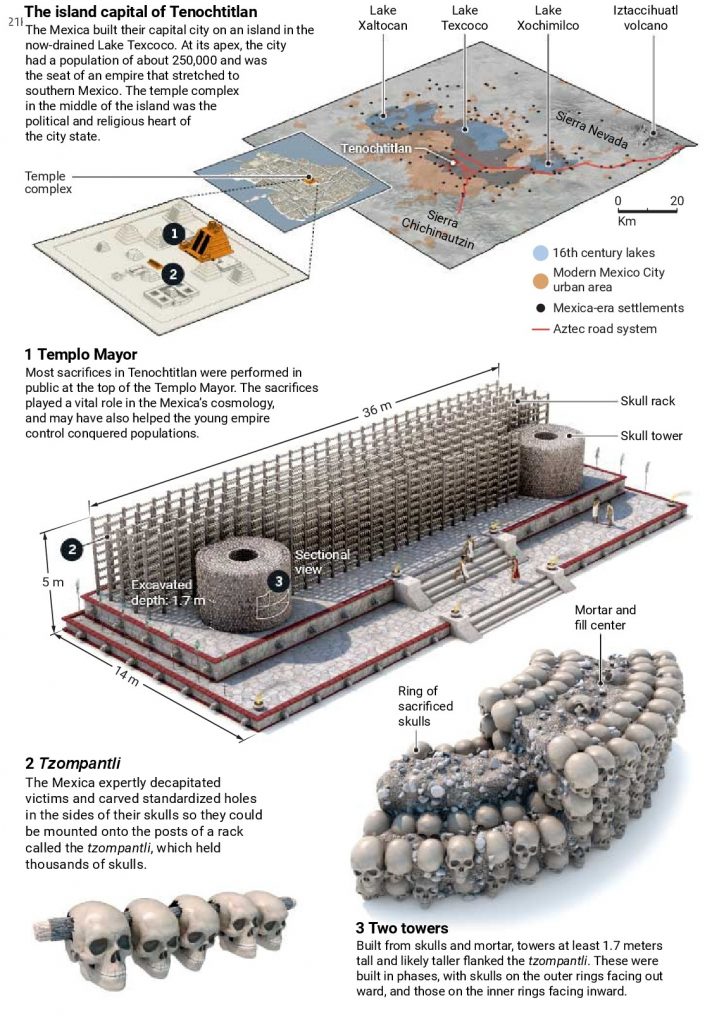
Nearby, the researchers also found skulls apparently stuck together with mortar—remnants of one of the towers flanking the tzompantli, where most skulls once exhibited on its posts ended their postmortem journey.
The team spent a second season, from October 2016 to June 2017, excavating the tzompantli and the tower. At its largest, the tower was nearly 5 meters in diameter and at least 1.7 meters tall.
More recently, in March 2020, new sections of the tower at the capital’s Templo Mayor Aztec site as well as 119 skulls of men, women and children were discovered.
Combining the two historically documented towers and the rack, INAH archaeologists now estimate that several thousand skulls must have been displayed at a time.
Other Mesoamerican cultures also engaged in human sacrifice and built tzompantlis. But, “The Mexica certainly brought this to an extreme,” says Vera Tiesler, a bioarchaeologist at the Autonomous University of Yucatán in Mérida, Mexico.
In her work at the Mayan city of Chichen Itza, founded some 700 years before Tenochtitlan and more than 1000 kilometers away, she found six skulls with holes in their sides that she suspects were once displayed on the posts of a tzompantli.
However, the holes in each skull were less regular and uniform than those in the Tenochtitlan skulls. “That makes me think it was not a standardized practice yet,” she says. “Tenochtitlan was the maximum expression [of the tzompantli tradition].“
Human sacrifice occupied a particularly important place in Mesoamerica.
Many of the region’s cultures, including the Maya and the Mexica, believed that human sacrifice nourished the gods. Without it, the sun would cease to rise and the world would end.
And sacrificial victims earned a special, honored place in the afterlife.
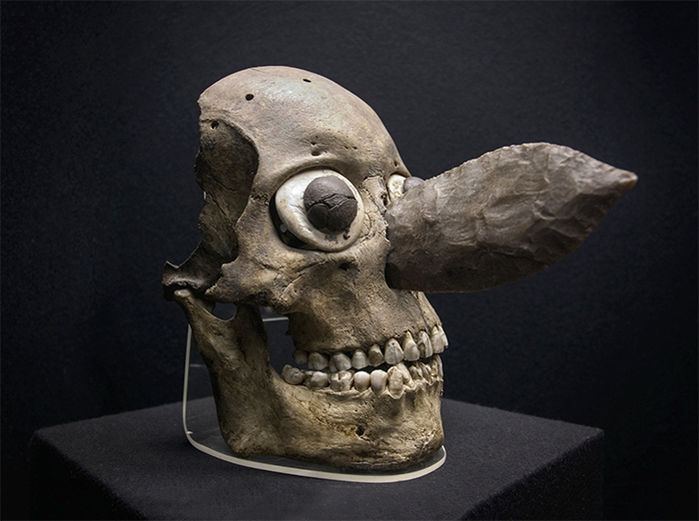
Ritual killings in traditional cultures elsewhere in the world, including Asia and Europe, point to additional roles for the practice, and may help explain why the Mexica took it to such an extreme. “All premodern societies make some kind of offering,” Verano says. “And in many societies, if not all, the most valuable sacrifice is human life.”
Social scientists who study religion have shown that costly offerings and painful rituals, such as the bloodletting ceremonies the Mexica also practiced, can help define and strengthen group identity—especially in societies that have grown too large for everyone to know everyone else.
Some researchers also argue that killing captives or subjects both establishes and reinforces hierarchy in large, complex societies. A 2016 Nature paper, for example, linked human sacrifice to the development of social stratification in dozens of traditional Austronesian cultures.
Many researchers say that, for the Mexica, political power as well as religious belief is likely key to understanding the scale of the practice. Theirs was a relatively young empire; during their 200-year reign, they conquered territory all over central and southern Mexico, sometimes facing tremendous resistance from local communities (some of which would later ally with the Spanish against the empire).
Spanish chronicles describe Tenochtitlan’s sacrificial victims as captives brought back from wars, such as those fought with their archenemy, the nearby republic of Tlaxcala. Subject peoples in the Mexica Empire were also sometimes required to send individuals as tribute. “The killing of captives, even in a ritual context, is a strong political statement,” Verano says. “It’s a way to demonstrate power and political influence—and, some people have said, it’s a way to control your own population.”
“The more powerful a state was, the more victims it could dedicate,” says Ximena Chávez Balderas, an INAH bioarchaeologist who spent years studying the remains of sacrificial victims in offerings in the Templo Mayor; she is now Verano’s doctoral student at Tulane. The religious significance and political messaging of human sacrifice “go hand in hand,” she says.
Over two seasons of excavations, INAH archaeologists collected 180 mostly complete skulls from the tower as well as thousands of skull fragments. Now, those finds sit in a lab next to the Templo Mayor ruins, being painstakingly examined by a team led by INAH anthropologist Jorge Gómez Valdés.
Cut marks on the skulls leave no doubt they were defleshed after death, and the decapitation technique appears clean and uniform. “[Mexica priests] had extremely impressive anatomical knowledge, which was passed down from generation to generation,” Chávez Balderas says.
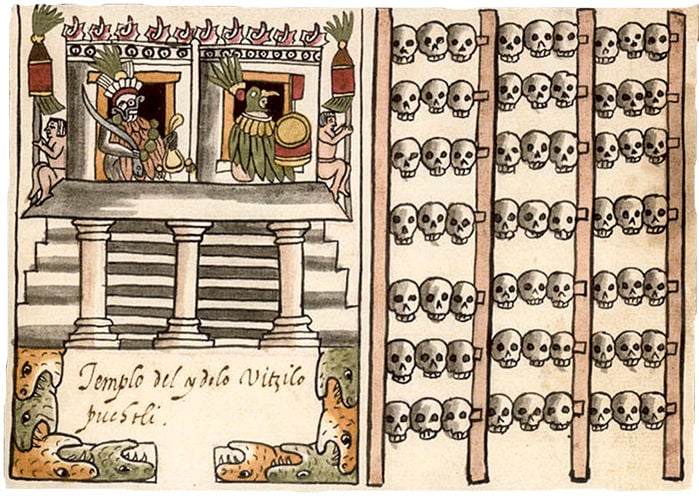
Gomóz Valdás found that about 75% of the skulls examined so far belonged to men, most between the ages of 20 and 35—prime warrior age. But 20% were women, and 5% belonged to children.
Most victims seemed to be in relatively good health before they were sacrificed. “If they are war captives, they aren’t randomly grabbing the stragglers,” Gómez Valdés says.
The mix of ages and sexes also supports another Spanish claim, that many victims were slaves sold in the city’s markets expressly to be sacrificed.
Chávez Balderas identified a similar distribution of sex and age in her studies of victims in smaller offerings within the Templo Mayor itself, which often contained skulls from the tzompantli that had been decorated and turned into eerie masks.
Her colleagues also analyzed isotopes of strontium and oxygen that the teeth and bones had absorbed. The isotopes in teeth reflect the geology of a person’s surroundings during childhood, whereas isotopes in bones show where a person lived before death.
The results confirmed that the victims were born in various parts of Mesoamerica but had often spent significant time in Tenochtitlan before they were sacrificed. “They aren’t foreigners who were brought into the city and directly to the ritual,” Chávez Balderas says. “They were assimilated into the society of Tenochtitlan in some way.“
Barrera Rodríguez says some historical accounts record cases of captive warriors living with the families of their captors for months or years before being sacrificed.
Samples for isotopic analysis as well as ancient DNA studies have already been taken from many of the tzompantli skulls, Gómez Valdés says. He, too, expects to find a diversity of origins, especially because the tzompantli skulls display a variety of intentional dental and cranial modifications, which were practiced by different cultural groups at different times.
If so, the skulls could yield information that extends far beyond how the victims died. “Hypothetically, in this tzompantli, you have a sample of the population from all over Mesoamerica,” Vázquez Vallín says. “It’s unparalleled.“
Bioarchaeologist Tiffiny Tung of Vanderbilt University in Nashville, who studies human sacrifice in the Andes, says she is excited to see what the INAH team can learn from the skulls about sacrificial rituals and the genetic diversity of Mesoamerica just before the conquest. “We can go down literally to the individual person and tell that person’s story. And then we can pull back and tell the story … about these big communities,” she says. Once imbued with a sacred, but silent, role in the city where they died, those victims may finally speak again.
More archeological news on Science, Strange Sounds and Steve Quayle.
If you are already planning your Christmas gifts, please buy with us on Amazon. The affiliate sales will help us to continue the hard work we are putting in this website.

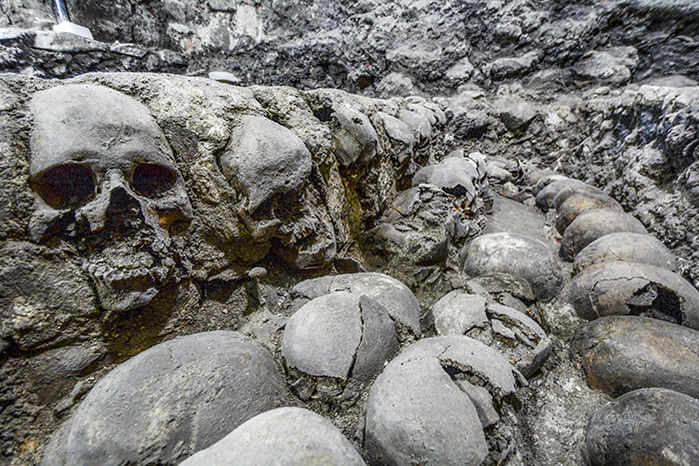








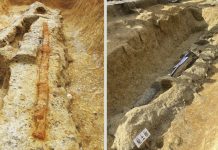
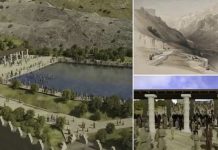

[…] Original Article:http://strangesounds.org/2018/06/feeding-the-gods-hundreds-of-skulls-reveal-massive-scale-of-human-s… […]
Your Bottled Water is Filled With Fluoride! Learn What Brands to Avoid!
https://www.davidwolfe.com/bottled-water-fluoride-brands-avoid/
*New SuperVolcano*Fire Updates 416-Pawnee*ET’S Harvesting Stars*Global Flooding Continues*
https://www.youtube.com/watch?v=urx4HdM4J7Y
*Something Is Building Under New England*New Tick Disease Can Kill In 48 Hours*Florida Sinkholes*
https://www.youtube.com/watch?v=gnSTWhTIMbs
UFO? Bizarre ‘roll cloud’ in Tennessee stuns residents
http://www.foxnews.com/science/2018/06/26/ufo-bizarre-roll-cloud-in-tennessee-stuns-residents.html
‘SUPERSONIC TIC TAC’ UFO STALKED US AIRCRAFT CARRIER FOR DAYS, PENTAGON REPORT REVEALS
GSM Update 6/26/18 – More Juneuary Snow – Flooding – Wildfire Update – California Volcano Threat
https://www.youtube.com/watch?v=YbsdQ2x8NfA
INSANE FLOOD IN ATHENS, GREECE | June 26, 2018
https://www.youtube.com/watch?v=IvlXssDW24k&list=UUXqiR3oMm0MlT06ms1o6z5A
Floods in Greece (Sithonia – Halkidiki)
https://www.youtube.com/watch?v=NRSxM5jAYKc
Agios Nikolaos Halkidiki – Flood (26/6/2018)
https://www.youtube.com/watch?v=zy1tPmoqKa8
Denied bathroom breaks, these workers must resort to diapers
https://www.cbsnews.com/news/denied-bathroom-breaks-these-workers-must-resort-to-diapers/
Beyond the low wages and high injury rates, the nation’s roughly 250,000 poultry workers are routinely denied bathroom breaks, leading some to wear diapers and others to not drink liquids. That’s according to a report released by Oxfam America, which details conditions that violate U.S. workplace safety laws.
The U.S. arm of the U.K.-based global development group called on Tyson Foods (TSN), Pilgrim’s Pride (PPC), Perdue Farms and Sanderson Farms, which together control nearly 60 percent of America’s poultry market, to improve workers’ conditions.
“It’s just basic human dignity, the right to be able to use the bathroom when you need to, as opposed to having to hold it for two hours until the next break, or worse, having to wear diapers or urinating or defecating on yourself,” Hunter Ogletree, an organizer at the Western North Carolina Workers’ Center, told CBS MoneyWatch.
Most of workers in Pilgrim’s Pride (PPC) in Russellville Alabama are from Africa. PPC has been recruiting workers from Ethiopia, Sudan, and Somalia. What they do is plucking feathers and butchering meat for a whole day.
Morgan County flooding causes road blockages
http://www.abc17news.com/weather/morgan-county-flooding-causes-road-blockages/759080852
Something “HUGE” Just Happened Over The UK! 2018
https://www.youtube.com/watch?v=9KuKluSTx4I
A huge cloudship over London, UK. Whenever you see a cloud, especially strange shape cloud, that should be a cloudship, a spaceship disguising as a cloud. Galactic Federation of Light does not want people to be scared by showing their real figures of their spaceships. That is why they are cloaking as clouds.
26 June 2018
https://www.youtube.com/watch?v=yoA7Lf65Hp4
Seven People Dead After Flash Floods Hit Northern Vietnam
https://www.youtube.com/watch?v=PJs8wuVP6oA
Floods, landslides in northern Vietnam kill 17, leave 11 missing
https://www.youtube.com/watch?v=T0LC_9OpTss
Thousands told to evacuate Northern California wildfire
https://www.youtube.com/watch?v=icpkqmzuk38
State Of Emergency Declared In Lake County Over Pawnee Fire
https://www.youtube.com/watch?v=ZU3HYpxn57c
Munster, IN – Manhole Cover about to Burst from Heavy Morning Rains – June 26th, 2018
https://www.youtube.com/watch?v=43f_d1XIszA
Earthquake in Hawaii, Volcano – June 24, 2018
https://www.youtube.com/watch?v=occP-a57Xf8
Apocalyptic flooding collapses buildings in China – June 24, 2018
https://www.youtube.com/watch?v=7jwH96bdF6U
★ LiveLeak || Moment buildings collapse in China downpours
https://www.youtube.com/watch?v=ujPRI6PUscI
Today, Lockheed Martin Alien Base in Orion, Alabama was bombarded by lightnings. Yes, many of pesky reptilians have come from Orion belt. That is why they love to name places, companies, restaurants, etc… Orion! When we stopped near this Lockheed Martin Alien Base in Orion to let my sons pee, we found some girls and boys underwear spreading around the area. Are they raping and eating young human girls and boys in this area? Then suddenly we found that we were surrounded by their security cars. We had place to go, so we just left. I am glad that Galactic Federation of Light cleaned up this area, today!
https://www.lightningmaps.org/?lang=en#t=3;s=0;o=0;b=0.00;m=gxs;ts=0;z=13;y=31.96;x=-85.9964;d=2;dl=2;dc=0;
END TIMES SIGNS LATEST EVENTS AND GOD’S WARNING (JUN 26, 2018) THIS HAPPENED ON OUR EARTH
https://www.youtube.com/watch?v=n0cErdTmzvE
How did they decide who should had been eaten by those human eater Reptilian aliens who were called GOD?
Answer is by playing a ball game such as soccer. The lost soccer team members were the ones to be eaten by GOD. Actually all the games had been created in order to choose who were going to be eaten by Reptilian GOD.
Draconian Reptoids Eating Humans
https://www.youtube.com/watch?v=-NpyKfQdyR8
shape shifting reptilian draco’s part 8
https://www.youtube.com/watch?v=xwKUQ05ZsGw&list=UUTbe36SeVwjDfotsl_45nFg&index=89
Reptilians – Everything You Wanted To Know
https://www.youtube.com/watch?v=y4Skmwn4acI
On this video, at 7:44, you can see 3 ridges on the reptilian head. I saw a manager in Walmart in Tucker, Georgia with those 3 ridges on his head. When I went to return an airbed in Walmart in Tucker, GA, a manager was called for my airbed return. Then a manager with those 3 ridges all the way from his forehead to his back of his head. He looked a quite handsome black guy except he had alien looking 3 ridges on his head. Next day, he passed beside me when I went to Walmart, again. But I could not find his 3 ridges on his head anymore! That means he has the ability to shape-shift himself. That was in 2011, I don’t know he is still working as a manager. But I tell you Walmart itself is Reptilian entity. Major Walmart has underground facilities connected to other underground cities and underground bases with underground tunnel system. Yes, many of Walmart employees might be aliens (reptilians and grays).
I myself caught many reptilian shape-shift by just slowing down Youtube video. I used Snipping tool and posted those images on my blog to show reptilian shape-shift to Japanese people until my blog had been taken over by Reptilian entity. The following video is good to show you how their figure can be changed. Those human figures are just holograms, projected image just like a movie projection in the movie theater. If their vibrations are changed by their emotional excitement, it is possible that they cannot keep their human figures.
Reptilian Saudi Prince Hand Shapeshifting
https://www.youtube.com/watch?v=UHtZlkbMBzM&list=UUFBaGXpMzhyRh-IDj9p2A2g&index=63